Asp.net Core 系列之--5.认证、授权与自定义权限的实现
ChuanGoing 2019-11-24
asp.net core系列已经来到了第五篇,通过之前的基础介绍,我们了解了事件订阅/发布的eventbus整个流程,初探dapper ORM实现,并且简单的介绍了领域模型、领域仓储及服务实现,结合上一篇的日志、错误处理及事务和本篇将要介绍的权限,大致的可以形成一个简单的后端系统架构。当然这些都是零散的一些技术概念的介绍,后面如果有时间的话,我想详细的介绍下如何利用领域驱动来实现一个实际案例。
话不多讲,下面来看下本篇的学习曲线:
1.认识Identityserver4
2.Identityserver4实现认证与授权
3.自定义权限的实现
认识Identityserver4
关于Identityserver4(ids4)的概念介绍,请查看IdentityServer4 知多少-简书一文。我这里要说的是,asp.net core 下的ids4集成了认证与授权两大功能,使得我们非常方便的实现一个开放的认证与授权平台,比如公司内部多个系统的集成登录(单点登录)/第三方系统数据共享/统一的认证中心等。整个业务流程大致为:
1.用户首先的有用户中心的账号信息,因此需要注册一个账号
2.用户访问某个站点应用,需要去到用户中心认证
3.认证通过,用户得到其在用户中心注册的相应信息及其权限时限、范围、大小
4.认证不通过,即非法用户,提示用户注册
5.在第3步的前提下,若用户访问到另一个站点(采用同一认证平台),这时用户可以用之前认证通过后拿到的访问令牌访问此站点,若此令牌中包含此站点的相应权限即可之前登录。
Identityserver4实现认证与授权
首先,新建一个asp.net core web 空项目,并且添加如下IdentityServer4 Nuget包
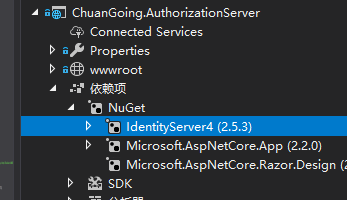
在ConfigureServices添加如下代码

注册IdentityServer中间件,如下5个配置分别表示:
1.AddDeveloperSigningCredential:开发模式下的签名证书,开发环境启用即可
2.AddInMemoryApiResources:相关资源配置
public static IEnumerable<ApiResource> GetApiResources()
{
return new List<ApiResource>
{
new ApiResource("WebApi", "ChuanGoingWebApi"),
new ApiResource("ProductApi", "ChuanGoingWebProduct")
};
}
GetApiResources
这里配置了两个Api资源
3.AddInMemoryIdentityResources:OpenID Connect相关认证信息配置
public static IEnumerable<IdentityResource> GetIdentityResources()
{
return new List<IdentityResource>
{
new IdentityResources.OpenId(),
new IdentityResources.Profile()
};
}
GetIdentityResources
4.AddInMemoryClients:客户端信息配置
public static IEnumerable<Client> GetClients(IConfiguration Configuration)
{
var OnlineConfig = Configuration.GetSection("OnlineClient");
var List = new List<Client>
{
new Client()
{
ClientId = "ClientCredentials",
AllowedGrantTypes = GrantTypes.ClientCredentials,
ClientSecrets = { new Secret("ClientSecret".Sha256()) },
AllowedScopes =
{
IdentityServerConstants.StandardScopes.OpenId,
IdentityServerConstants.StandardScopes.Profile,
"WebApi",
"ProductApi"
},
AccessTokenLifetime = * *
}, new Client()
{
ClientId = "ResourceOwnerPassword",
AllowedGrantTypes = GrantTypes.ResourceOwnerPassword,
ClientSecrets = { new Secret("ClientSecret".Sha256()) },
AllowedScopes =
{
IdentityServerConstants.StandardScopes.OpenId,
IdentityServerConstants.StandardScopes.Profile,
"WebApi",
"ProductApi"
},
AccessTokenLifetime = * *
},
/*
隐式模式:https://localhost:6005/connect/authorize?client_id=Implicit&redirect_uri=http://localhost:5000/Home&response_type=token&scope=WebApi
*/
new Client()
{
ClientId = "Implicit",
ClientName = "ImplicitClient",
AllowedGrantTypes = GrantTypes.Implicit,
ClientSecrets = { new Secret("ImplicitSecret".Sha256()) },
RedirectUris ={OnlineConfig.GetValue<string>("RedirectUris") },
PostLogoutRedirectUris = {OnlineConfig.GetValue<string>("LogoutRedirectUris") },
AllowedScopes =
{
IdentityServerConstants.StandardScopes.OpenId,
IdentityServerConstants.StandardScopes.Profile,
"WebApi",
"ProductApi"
},
AccessTokenLifetime = * * ,
//允许将token通过浏览器传递
AllowAccessTokensViaBrowser=true
},
/*
* 授权码模式:https://localhost:6005/connect/authorize?client_id=GrantCode&redirect_uri=http://localhost:5000/Home&response_type=code&scope=WebApi
*/
new Client()
{
//客户端Id
ClientId="GrantCode",
ClientName="GrantCodeClient",
//客户端密码
ClientSecrets={new Secret("CodeSecret".Sha256()) },
//客户端授权类型,Code:授权码模式
AllowedGrantTypes=GrantTypes.Code,
//允许登录后重定向的地址列表,可以有多个
RedirectUris ={OnlineConfig.GetValue<string>("RedirectUris") },
//允许访问的资源
AllowedScopes={
"WebApi",
"ProductApi"
}
}
};
return List;
}
GetClients
分别对象Auth2.0的四种模式,本篇将用到的是ResourceOwnerPassword模式,其他几种可在篇尾github链接查看源码的实现
5.AddTestUsers:用户配置,可结合缓存/持久化
public static List<TestUser> GetUsers()
{
return new List<TestUser>
{
new TestUser
{
SubjectId = Guid.NewGuid().ToString(),
Username = "admin",
Password = "" //Claims = new List<Claim>
//{
// new Claim("name", "admin"),
// new Claim("website", "https://www.cnblogs.com/chuangoing")
//}
},
new TestUser
{
SubjectId = Guid.NewGuid().ToString(),
Username = "chuangoing",
Password = "" //Claims = new List<Claim>
//{
// new Claim("name", "chuangoing"),
// new Claim("website", "https://github.com/chuangoing")
//}
}
};
}
GetUsers
定义两个测试用户,注意这里的SubjectId,用作用户中心注册的openid(认证唯一),后面将会用到
然后,Configure中添加app.UseIdentityServer();//启用ids4
至此,ids4 服务完成
用postman测试下:
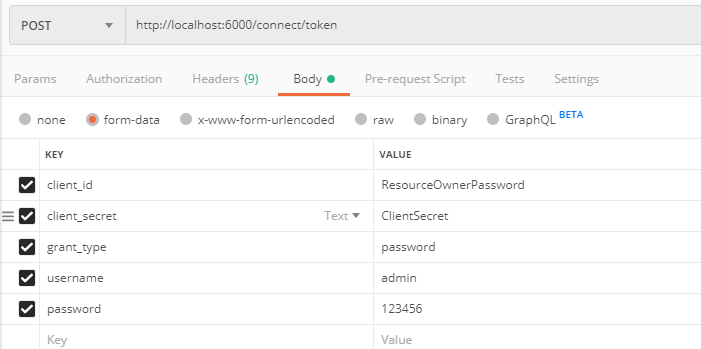
返回jwt accesstoken:

将token内容解码,如下:
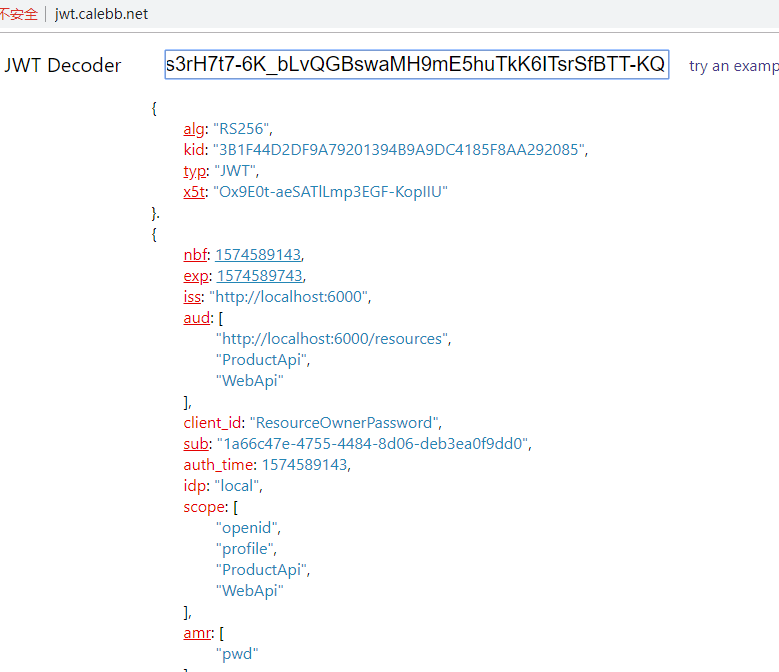
可以看到,里面包含我们配置的ProductApi/WebApi的权限
将token信息加入到http的header中:
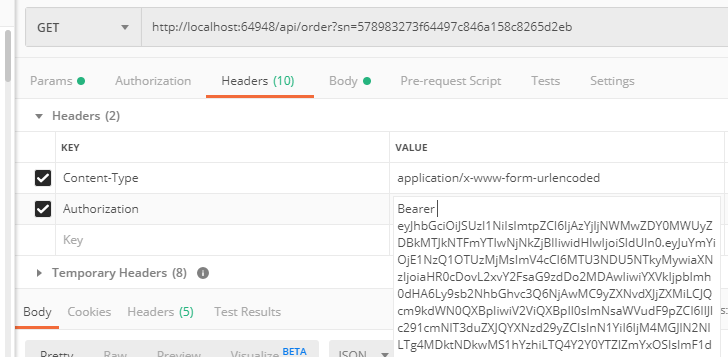
注意Bearer后面有个空格,访问order的获取订单信息:
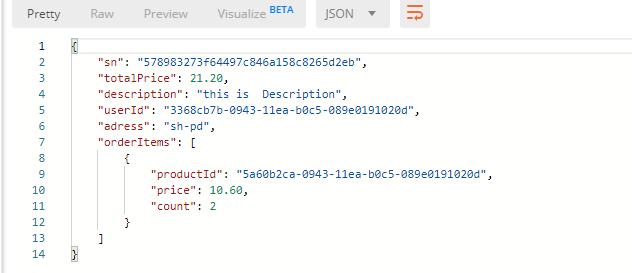
自定义权限的实现
这里,我们将api中的action分别定义一个权限代码,用户拥有了此action访问权限(拥有此权限代码)即可访问,简单实现如下:
1.定义权限特性标识,api的action指定某个标识
public class PermissionAttribute : Attribute
{
/// <summary>
/// 权限代码
/// </summary>
public string Code { get; }
/// <summary>
///
/// </summary>
/// <param name="code">权限代码</param>
public PermissionAttribute(string code)
{
Code = code;
}
}
PermissionAttribute

此处,get action定义了访问权限标识为"XYZ"
同样,我们这里需要用到一个权限过滤器,利用过滤器的Aop实现权限过滤业务处理:
public class PermissionFilter : ActionFilterAttribute
{
public override void OnActionExecuting(ActionExecutingContext context)
{
var user = context.HttpContext.User;
if (user.Identity.IsAuthenticated)
{
//TODO:用户自定义权限验证
Guid userId = context.HttpContext.GetId();
bool right;
#region 自定义权限验证
//根据userId判断用户内部系统权限信息 //var userPermissions = repo.GetUserPermissions(userId);
//var permissions = repo.GetPermissions();
var metas = context.ActionDescriptor.EndpointMetadata;
foreach (var meta in metas)
{
if (meta is PermissionAttribute permission)
{
//if (!permissions.Any(p => permission.Code.Any(c => c == p.Code))
// && !userPermissions.Any(p => permission.Code.Any(c => c == p.Code)))
//{
// throw new WebException(HttpStatusCode.Forbidden, MessageCodes.AccessDenied, "你没有访问该资源的权限");
//}
//break;
}
} right = false;
#endregion
if (!right)
{
context.Result = new ContentResult() { StatusCode = (int)HttpStatusCode.Forbidden, Content = "你没有访问该资源的权限" };
} }
}
PermissionFilter
同时,启用权限过滤器配置

部分代码略过,详细的请查看篇尾的源码链接
利用第二节的认证授权得到的token,我们用postman测试下:

过滤器切面成功工作
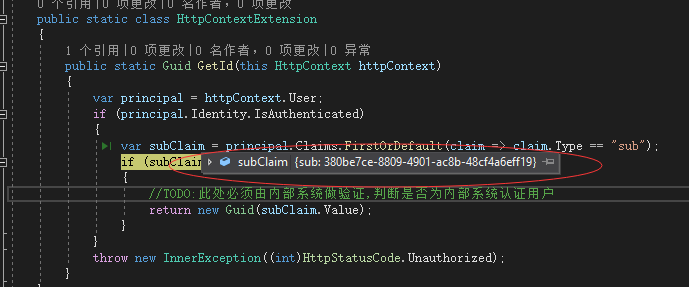
还记得第一节说的SubjectId么?这里利用这个openid,去内部系统去匹配相关用户信息,相关业务就不深入了,有兴趣的朋友可以下载示例完善下

至此,整个权限认证、授权、自定义权限介绍完。
WebApi详细代码在Github的https://github.com/ChuanGoing/Start.git 的Domain分支可以找到,AuthServer详细代码在https://github.com/ChuanGoing/Demo/tree/master/ChuanGoing.AuthorizationServer中。
Asp.net Core 系列之--5.认证、授权与自定义权限的实现的更多相关文章
- asp.net core 系列之用户认证(authentication)
ASP.NET Core 的 identity 是一种需要用户登录的会员系统,用户可以创建一个登录信息存储在 Identity 的的账号, 或者也可以使用第三方登录,支持的第三方登录包括:Facebo ...
- asp.net core 系列之用户认证(1)-给项目添加 Identity
对于没有包含认证(authentication),的项目,你可以使用基架(scaffolder)把 Identity的程序集包加入到项目中,并且选择性的添加Identity的代码进行生成. 虽然基架已 ...
- asp.net core 系列之中间件进阶篇-编写自定义中间件(middleware)
中间件是被用到管道(pipeline)上来处理请求(request)和响应的(response). asp.net core 本身提供了一些内置的中间件,但是有一些场景,你可能会需要写一些自定义的中间 ...
- 【转】ASP.NET Core WebAPI JWT Bearer 认证失败返回自定义数据 Json
应用场景:当前我们给微信小程序提供服务接口,接口中使用了权限认证这一块,当我使用 JWT Bearer 进行接口权限认证的时候,返回的结果不是我们客户端想要的,其它我们想要给客户端返回统一的数据结构, ...
- asp.net core 2.0的认证和授权
在asp.net core中,微软提供了基于认证(Authentication)和授权(Authorization)的方式,来实现权限管理的,本篇博文,介绍基于固定角色的权限管理和自定义角色权限管理, ...
- 【转载】asp.net core 2.0的认证和授权
在asp.net core中,微软提供了基于认证(Authentication)和授权(Authorization)的方式,来实现权限管理的,本篇博文,介绍基于固定角色的权限管理和自定义角色权限管理, ...
- 【ASP.NET Core】运行原理(4):授权
本系列将分析ASP.NET Core运行原理 [ASP.NET Core]运行原理(1):创建WebHost [ASP.NET Core]运行原理(2):启动WebHost [ASP.NET Core ...
- ASP.NET Core系列(二):创建第一个.Net Core 项目
前面讲过 .NET Core简介及开发环境安装,本章会讲一讲ASP.NET Core 2.0的项目结构,查看完整的ASP.NET Core系列文章:https://www.cnblogs.com/zh ...
- 【目录】asp.net core系列篇
随笔分类 - asp.net core系列篇 asp.net core系列 68 Filter管道过滤器 摘要: 一.概述 本篇详细了解一下asp.net core filters,filter叫&q ...
随机推荐
- jmeter-使用代理服务器录制脚本
使用代理服务器录制脚本 1.测试计划-添加线程组 2.工作台添加HTTP代理服务器(路径:工作台-右键添加-非测试元件-HTTP代理服务器) 3.端口号一般由8888改为其他的 4.打开chrome的 ...
- 以np.concatenate为主题,谈谈numpy数组按维度合并的问题
1.引言 最近在做多模态融合的图像问题,其中最需要解决的就是不同模态的图像用什么方法进行融合,最简单也最直观的方法就是采用合并数组的方法,将不同模态的图像合并为多通道进行处理.在一些论文中,比如< ...
- nuxt.js部署vue应用到服务端过程
由于seo的需要,最近将项目移植道nuxt.js下采用ssr渲染 移植完成后,一路顺畅,但是到了要部署到服务器端上时候,还是个头疼的问题,但最终还是顺利完成.现在记录一下部署中的过程. 注:部署时候过 ...
- win7更新,360手机安装谷歌框架
这两天把11平台被卸载了,不能打竞技场了,很伤心. 成年男子,总要找点有趣的事情去做.我准备洗心革面,好好学习.(巴拉巴拉巴拉一万字.) 首先第一件事情就是重装系统,(由于买了个假显卡,win10以上 ...
- JAVA nio 简单使用
nio 模拟客户端和服务器互相通讯--传输一个int值,并且不断的+1: 服务器,单线程 public class Server { public static void main(String[] ...
- Log4j slf4j 配置简单介绍
Log4j slf4j 配置简单介绍 先借鉴一篇很好的文章 为什么要使用SLF4J而不是Log4J import org.slf4j.Logger; import org.slf4j.LoggerFa ...
- C#控件的简单应用
listview 创建columns: ImageList imgList = new ImageList(); imgList.ImageSize = , ); FaceListview.Small ...
- vue cli3.3 以上版本配置vue.config.js
// vue.config.js 配置说明//官方vue.config.js 参考文档 https://cli.vuejs.org/zh/config/#css-loaderoptions// 这里只 ...
- json基本内容
json的基本信息和历史 JSON(JavaScript Object Notation) 是一种轻量级的数据交换格式.它基于欧洲计算机协会制定的js规范的一个子集,采用完全独立于编程语言的文本格式来 ...
- 无法打开msvcrtd.lib
